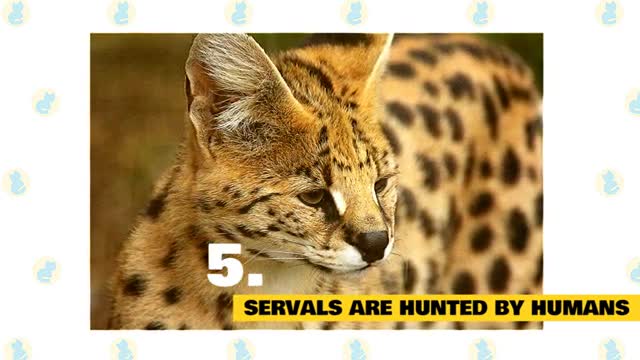Premium Only Content

Serval Cats 101 : Fun Facts & Myths
In today's video, we are going to talk about some interesting facts and myths about the Serval Cat.
Servals are medium-sized wild cats with tawny, black-spotted coats and long necks and long legs that allow them to see over savanna grasses. They also have large ears and an acute sense of hearing.
The serval cat is a beautiful animal that some people keep as an exotic pet. While you may be able to acquire a serval cat from a breeder, they are considered wild cats. To own a serval cat, you must create a large, secure outdoor enclosure and provide a warm environment year-round. They will need to feed on whole prey food items and require veterinary care from an experienced exotics vet.
Here are some of the interesting facts about the Serval Cat, which will give you some further insight into its characteristics and temperament.
1. Serval Cat's Size and Appearance.
Often referred to as the cat of spare parts, this unusual, but the beautiful cat is among the feline family’s most successful. It has a small, delicate head and extremely large ears set on an elongated neck, long slim legs, hind legs longer than the front, a long slender body, and a short tail. The ears are black on the back with a distinctive white spot, and the tail has 6 or 7 black rings and a black tip.
The coat color is pale yellow with black markings, either of large spots that tend to merge into longitudinal stripes on the neck and back, or of numerous small spots, which give a speckled appearance. These "speckled" Servals from West Africa used to be considered a separate species of Felis Brachyura until it was demonstrated that the speckled pattern was just a "morph".
2. Serval Cat's Behaviour.
They are solitary animals. The serval is active in the day as well as at night; activity might peak in the early morning, around twilight, and at midnight. Servals might be active for a longer time on cool or rainy days. During the hot midday, they rest or groom themselves in the shade of bushes and grasses.
Servals remain cautious of their vicinity. Servals walk as much as 2 to 4 kilometers every night. Servals will often use special trails to reach certain hunting areas. A solitary animal, there is little social interaction among servals except in the mating season. The only long-lasting bond appears to be of the mother and her cubs, which leave their mother only when they are a year old.
The female defends home ranges of 9.5 to 19.8 square kilometers, depending on local prey availability. The male defends larger territories of 11.6 to 31.5 square kilometers and marks its territory by spraying urine onto bushes.
The serval is vulnerable to hyaenas and wild dogs. It will seek cover to escape their view, and, if the predator is very close, immediately flee in long leaps, changing its direction frequently and with the tail raised. They are efficient climbers. An individual was observed to have climbed a tree to a height of more than 9 meters to escape dogs. Like many cats, the serval is able to purr, it also has a high-pitched chirp and can hiss, cackle, growl, grunt, and meow.
3. Serval Cat's Habitat.
Servals are found in well-watered savannah long-grass environments and are associated with reed beds and other riparian vegetation types. They occupy a variety of habitats all associated with water sources, they range up into alpine grasslands and can penetrate deep dense forests along waterways and through grassy patches, but are absent from rain forests. They will make use of arid areas in extreme instances and have occasionally done so in parts of south-western Africa.
4. Serval Cat's Hunting and Diet.
The serval’s sensitive hearing allows it to locate small mammals moving through the grass or underground, and to hunt its prey sometimes without seeing it until the final pounce. Servals are carnivores, which means they eat meat. Servals also have the ability to leap vertically and catch prey such as birds, right out of the air. They do this by "clapping" with their front paws together and striking with a downward blow. Primary prey items for the Serval include rodents, birds, reptiles, fish, frogs, insects, and crabs. Servals have a hunting success rate of 50%.
Do not be alarmed if your serval eats so fast, that it regurgitates everything right back up due to clogging its throat. It may attempt to re-eat the regurgitated food if has not started fermenting from its stomach acid.
When feeding them, a game or puzzle that makes the cat problem-solve will enable the meal to be more rewarding and counts as an enrichment activity in their daily routine.
-
 4:14
4:14
NewMexicoRed
3 years agoNew Mexico Fun Facts Part 1
10 -
 3:31
3:31
jonnysunami15
4 years ago $0.01 earnedSwans! 5 Facts from the Fun Facts Channel!
31 -
 1:58:10
1:58:10
Robert Gouveia
16 hours agoMatt Gaetz REJECTS Report, Sues Committee; Luigi Fan Club Arrives; Biden Commutes; Festivus Waste
206K139 -
 58:10
58:10
Kimberly Guilfoyle
18 hours agoAmerica is Back & The Future is Bright: A Year in Review | Ep. 183
110K62 -
 3:03:27
3:03:27
vivafrei
23 hours agoEp. 242: Barnes is BACK AGAIN! Trump, Fani, J6, RFK, Chip Roy, USS Liberty AND MORE! Viva & Barnes
202K207 -
 8:09:50
8:09:50
Dr Disrespect
21 hours ago🔴LIVE - DR DISRESPECT - MARVEL RIVALS - GOLD VANGUARD
211K34 -
 1:15:00
1:15:00
Awaken With JP
20 hours agoMerry Christmas NOT Happy Holidays! Special - LIES Ep 71
272K219 -
 1:42:21
1:42:21
The Quartering
22 hours agoTrump To INVADE Mexico, Take Back Panama Canal Too! NYC Human Torch & Matt Gaetz Report Drops!
199K116 -
 2:23:15
2:23:15
Nerdrotic
21 hours ago $15.98 earnedA Very Merry Christmas | FNT Square Up - Nerdrotic Nooner 453
147K13 -
 1:14:05
1:14:05
Tucker Carlson
21 hours ago“I’ll Win With or Without You,” Teamsters Union President Reveals Kamala Harris’s Famous Last Words
253K393